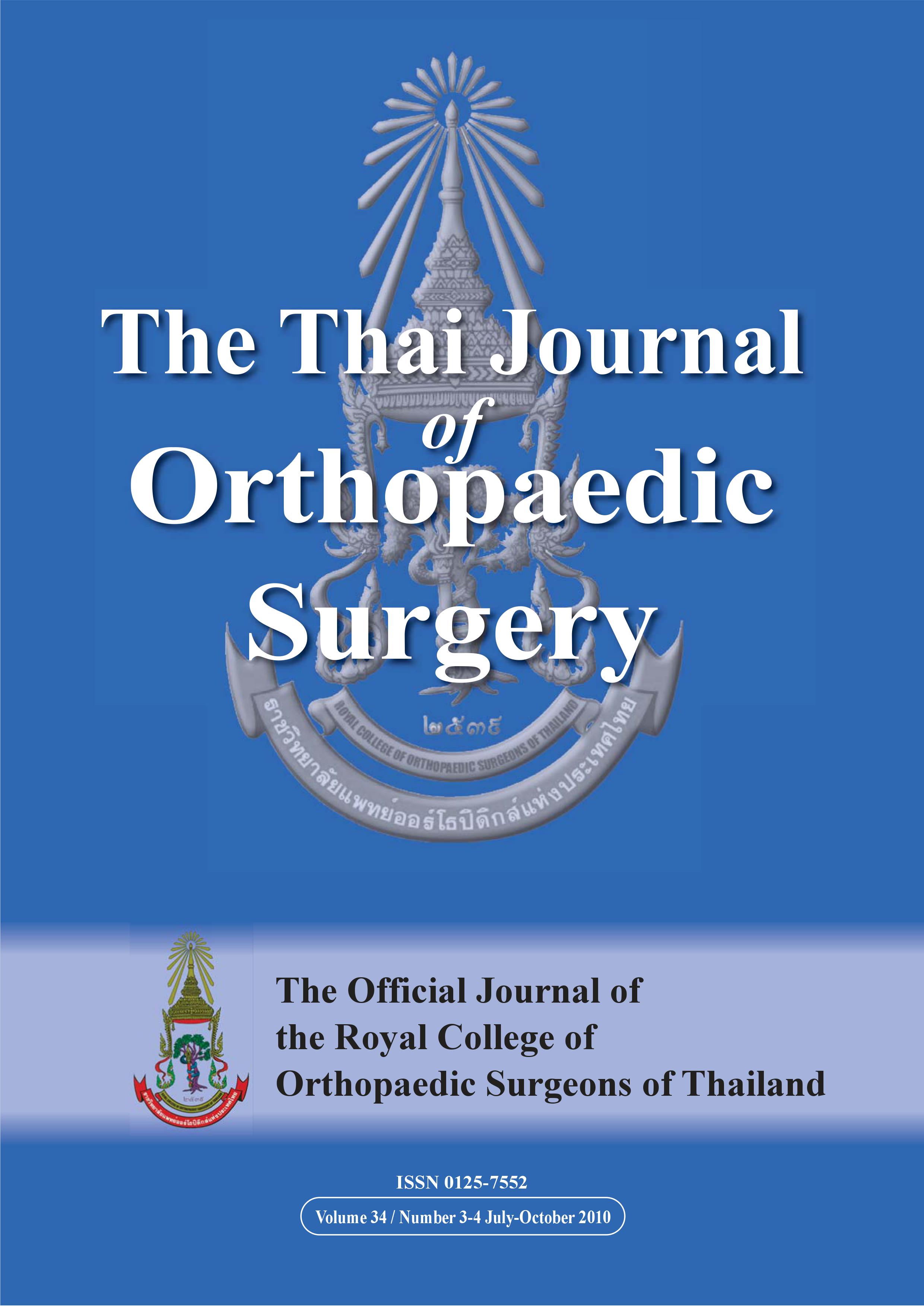Human Bite Injuries of the Hand at Sawanpracharak Hospital: 10 years of experience
Main Article Content
Abstract
Objective: To study patient characteristics, nature of injury, time to receive treatment, treatment procedure, and final outcome in patients with human bite injuries on the hand.
Methods: Retrospective, descriptive study in 45 patients with hand wounds from bites who were treated in Sawanpracharak Hospital from January 1st, 2000 to December 31st, 2009. Data was collected from medical records and presented by descriptive statistics. Patient characteristics and outcomes were compared between patients who received treatment within 48 hours and after 48 hours by Exact test and t-test.
Results: All patients were males, mean age 29.2±9.0 years. 84.4% of the lesions were on the right hand and 57.8% of lesions were at the MCP joint of the middle finger. Radiology found nine fractured metacarpal heads and one narrowing joint space. 55.5% had cellulitis, 37.8% had open joint injury, and 22.2% had tendon injury. 33.3% of wound cultures had Streptococcus spp. and 22.2% had Staphylococcus spp. Of the 21 patients who completed follow-up, 71.4% showed a good final function outcome. Patients who received treatment within 48 hours revealed fewer cellulitis (45.7% vs. 90.0%, p= 0.027), a lower average length of hospital stay (2.3±1.5 vs 11.8 ± 8.7, p= 0.007), and less joint stiffness (6.3% vs 100.0%, p = 0.001) than those who did not.
Conclusion: Time from injury to treatment and appropriate treatment were important factors in reducing complications.
Article Details
References
2. Wallace CG, Robertson CE. Prospective audit of 106 consecutive human bite injuries: the importance of history taking. Emerg Med J. 2005; 22(12): 883-4.
3. Godoy D, Bonadeo G, Peralta H. Fight bite injuries. The Internet journal of emergency medicine [serial online]. 2003; 1(2): Available from:URL:http://www.ispub.com/ostia/index.php?xmlFile Path=journals/ijem/vol1n2/bite. xml. Accessed Aug 19, 2010.
4. Zubowics VN, Gravier M. Management of early human bites of the hand: a prospective randomized study. Plast Reconstr Surg. 1991; 88(1): 111-4.
5. Oprasertsawat P. Human bite injury of the hand in Sawanpracharak Hospital. Sawanpracharak Medical Journal. 2008; 5(2); 881-90.
6. Tonta K, Kimble FW. Human bites of the hand: the Tasmanian experience. ANZ J Surg. 2001; 71(8): 467-71.
7. Hultgen JF. Partial gangrene of the left index finger caused by the symbiosis of the fusiform bacillus and the spirochaeta denticola. JAMA. 1910; 1: 857.
8. Peters WH. Hand infection apparently due to bacillus fusiformis. J Infect Dis. 1911; 8: 455-62.
9. Mason ML, Koch SL. Human bite infections of the hand. Surg Gynecol Obstet. 1930; 51: 591-625.
10. Perron AD, Miller MD, Brady WJ. Orthopedic pitfalls in the ED:fight bite. Am J Emerg Med. 2002; 20(2): 114-7.
11. Clark DC. Common acute hand infections. Am Fam Physician. 2003; 68(11): 2167-76.
12. Revis Jr DR. Human bite infections. Available from: http://www.emedicine.medscape.com/ article/218901-overview. Accessed Aug 19, 2010.
13. Houshian S, Seyedipour S, Wedderkopp N. Epidemiology of bacterial hand infections. Int J Infect Dis. 2006; 10(4): 315-9.
14. Barrett J, McNamara RM, Spanierman CS. Bites, human: treatment & medication [internet]. 2010 [updated 2010 Apr 8; cited 2010 Aug 19]. Available from: http://www. emedicine.medscape.com/article/768978-overview.
15. Chadaev AP, Jukhtin VI, Butkevich AT. Treatment of infected clenched-fist human bite wounds in the area of metacarpophalangeal joints. J Hand Surg Am. 1996; 21(2): 299-303.
16. Mennen U, Howells CJ. Human fight-bite injuries of the hand. J Hand Surg Br. 1991; 16(4): 431.
17. Griego RD, Rosen T, Orengo IF, Wolf JE. Dog, cat and human bites: a review. J Am Acad Dermatol 1995; 33(6): 1019-29.
18. Brook I. Management of human and animal bite wound infection: an overview. Curr Infect Dis Rep. 2009; 11(5): 389-95.
19. Goon KYP, Mahmoud M, Rajaratnam V. Hand trauma pitfalls: A retrospective study of fight bites. European Journal of Trauma and Emergency Surgery. 2004: 34(2): 135-40.
20. Brook I. Microbiology and management of human and animal bite wound infections. Prim Care. 2003; 30(1): 25-39.
21. Talan DA, Abrahamian FM, Moran GJ, Citron DM, Tan JO, Goldstein EJ, et al. Clinical presentation and bacteriologic analysis of infected human bites in patients presenting to emergency departments. Clin Infect Dis. 2003; 37(11): 1481-9.
22. Eyres KS, Allen TR. Skyline view of the metacarpal head in the assessment of human fight-bite injuries. J Hand Surg Br. 1993; 18(1): 43-4.
23. Morgan M. Hospital management of animal and human bites. J Hosp Infect. 2005; 61(1): 1-10.
24. Health protection agency north west. Guidelines for the management of human bite injuries [internet]. 2007 [cited 2010 Aug 19]. Available from: http://www.hpa-nw.org.uk.
25. Stefanopoulos P, Karabouta Z, Bisbinas I, Georgiannos D, Karabouta I. Animal and human bites: evaluation and management. Acta Orthop Belg. 2004; 70(1): 1-10.
26. Correira K. Managing dog, cat, and human bite wounds. JAAPA. 2003; 16(4): 28-32.
27. Therapeutic guidelines. Antibiotic. 11st ed. Melbourne: Therapeutic Guidelines Limited; 2000.
28. Wright PE. Hand infection. In: Canale ST, Beaty JH, editors. Campbell's operative orthopaedics. 10th ed. Philadelphia: Mosby Elsevier; 2003. p.4357.


